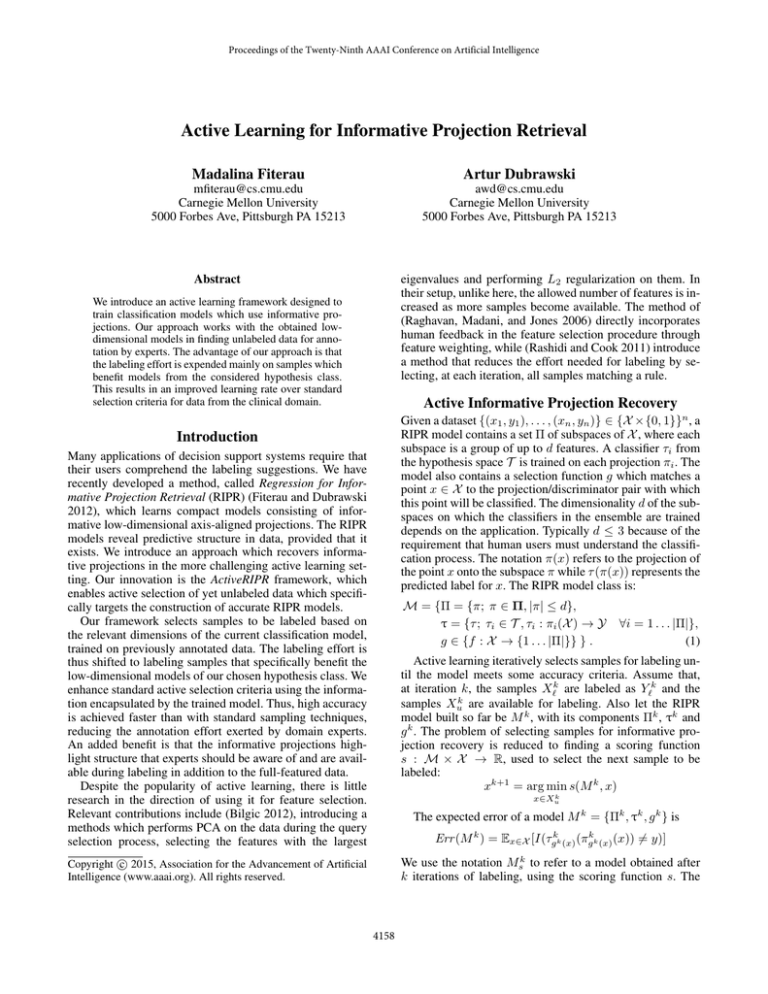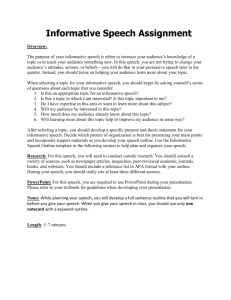
Proceedings of the Twenty-Ninth AAAI Conference on Artificial Intelligence
Active Learning for Informative Projection Retrieval
Madalina Fiterau
Artur Dubrawski
mfiterau@cs.cmu.edu
Carnegie Mellon University
5000 Forbes Ave, Pittsburgh PA 15213
awd@cs.cmu.edu
Carnegie Mellon University
5000 Forbes Ave, Pittsburgh PA 15213
eigenvalues and performing L2 regularization on them. In
their setup, unlike here, the allowed number of features is increased as more samples become available. The method of
(Raghavan, Madani, and Jones 2006) directly incorporates
human feedback in the feature selection procedure through
feature weighting, while (Rashidi and Cook 2011) introduce
a method that reduces the effort needed for labeling by selecting, at each iteration, all samples matching a rule.
Abstract
We introduce an active learning framework designed to
train classification models which use informative projections. Our approach works with the obtained lowdimensional models in finding unlabeled data for annotation by experts. The advantage of our approach is that
the labeling effort is expended mainly on samples which
benefit models from the considered hypothesis class.
This results in an improved learning rate over standard
selection criteria for data from the clinical domain.
Active Informative Projection Recovery
Given a dataset {(x1 , y1 ), . . . , (xn , yn )} ∈ {X ×{0, 1}}n , a
RIPR model contains a set Π of subspaces of X , where each
subspace is a group of up to d features. A classifier τi from
the hypothesis space T is trained on each projection πi . The
model also contains a selection function g which matches a
point x ∈ X to the projection/discriminator pair with which
this point will be classified. The dimensionality d of the subspaces on which the classifiers in the ensemble are trained
depends on the application. Typically d ≤ 3 because of the
requirement that human users must understand the classification process. The notation π(x) refers to the projection of
the point x onto the subspace π while τ (π(x)) represents the
predicted label for x. The RIPR model class is:
Introduction
Many applications of decision support systems require that
their users comprehend the labeling suggestions. We have
recently developed a method, called Regression for Informative Projection Retrieval (RIPR) (Fiterau and Dubrawski
2012), which learns compact models consisting of informative low-dimensional axis-aligned projections. The RIPR
models reveal predictive structure in data, provided that it
exists. We introduce an approach which recovers informative projections in the more challenging active learning setting. Our innovation is the ActiveRIPR framework, which
enables active selection of yet unlabeled data which specifically targets the construction of accurate RIPR models.
Our framework selects samples to be labeled based on
the relevant dimensions of the current classification model,
trained on previously annotated data. The labeling effort is
thus shifted to labeling samples that specifically benefit the
low-dimensional models of our chosen hypothesis class. We
enhance standard active selection criteria using the information encapsulated by the trained model. Thus, high accuracy
is achieved faster than with standard sampling techniques,
reducing the annotation effort exerted by domain experts.
An added benefit is that the informative projections highlight structure that experts should be aware of and are available during labeling in addition to the full-featured data.
Despite the popularity of active learning, there is little
research in the direction of using it for feature selection.
Relevant contributions include (Bilgic 2012), introducing a
methods which performs PCA on the data during the query
selection process, selecting the features with the largest
M = {Π = {π; π ∈ Π, |π| ≤ d},
τ = {τ ; τi ∈ T , τi : πi (X ) → Y
g ∈ {f : X → {1 . . . |Π|}} } .
∀i = 1 . . . |Π|},
(1)
Active learning iteratively selects samples for labeling until the model meets some accuracy criteria. Assume that,
at iteration k, the samples X`k are labeled as Y`k and the
samples Xuk are available for labeling. Also let the RIPR
model built so far be M k , with its components Πk , τk and
g k . The problem of selecting samples for informative projection recovery is reduced to finding a scoring function
s : M × X → R, used to select the next sample to be
labeled:
xk+1 = arg min s(M k , x)
k
x∈Xu
The expected error of a model M k = {Πk , τk , g k } is
Err (M k ) = Ex∈X [I(τgkk (x) (πgkk (x) (x)) 6= y)]
We use the notation Msk to refer to a model obtained after
k iterations of labeling, using the scoring function s. The
c 2015, Association for the Advancement of Artificial
Copyright Intelligence (www.aaai.org). All rights reserved.
4158
aim is to pick the query samples adequately, such that the
training error decreases (or at least not increases) with each
iteration: Err (Msk+1 ) ≤ Err (Msk ). Given the maximum
acceptable error , and a set S of scoring functions, selecting
the optimal strategy can be expressed as follows:
s∗ = arg min min{k s.t. Err (Msk ) ≤ }
k
s∈S
(2)
ActiveRIPR starts by requesting labels of a set of r0 randomly selected samples, building a RIPR model. The standard selection criteria are adapted to RIPR models. The uncertainty sampling score simply considers the lowest condik
tional entropy on the projections of the model Muncrt
:
suncrt (x) =
min
k
π∈Πk
uncrt ,τ ∈τ
ĥ(τ (π(x))|π(x))
Figure 1: ActiveRIPR on artificial and real data.
(3)
where ĥ denotes the conditional entropy estimator for a label
given a subset of the features and ŷ(x) is the prediction:
g k (x) :=
arg min
ĥ(τ (π(x))|π(x)); ŷ(x)
(π,τ )∈(Πk ,τk )
:= τgkk (x) (x)
k
is simply performed by comQuery by committee Mqbc
paring the labels assigned by each of the classifiers in τkqbc :
sqbc (x) =
max
τi ,τj ∈τk
qbc
I(τi (πi (x)) 6= τj (πj (x)))
(4)
In order to sample according to the information gain critek
rion, we use the notation ĤX
(X1 ) to represent the esti0 ,Y0
mated conditional entropy of the samples X1 given the samk
ples X0 and their labels Y0 . Let X`,ig
be the labeled samples
k
by and Xu,ig the unlabeled ones. The InfoGain score is:
k
∀x ∈ Xu,ig
,
k
k
sig (x) = ĤX
(Xu,ig
)
` ,Y`
Samples
20
50
75
k
k
k
k
− p0 ĤX
(Xu,ig
) − p1 ĤX
(Xu,ig
)
` ∪{x},Y` ∪{0}
` ∪{x},Y` ∪{1}
Selecting samples with high uncertainty makes sense
when there are aspects of the data not yet learned, however,
once the informative projections have been discovered, selecting samples with high uncertainty often leads to the selection of purely noisy samples. In this case, selecting the
data for which the classification is the most confident improves the model. The score for this query selection criteria
is simply the opposite of the uncertainty sampling score:
smc (x) = 1 −
min
k
π∈Πk
mc ,τ ∈τmc
We have also used ActiveRIPR to filter out alerts coming from a cardio-respiratory monitoring system, which collects multiple vital signs indicative of the health status of patients. The alerts, each associated to a vital sign, are issued
whenever some form of instability requires attention, however, a substantial fraction of these are triggered by malfunctions or inaccuracies of the sensing equipment (artifacts).
We extracted a total of 50 features, 800 labeled samples and
roughly 8000 unlabeled ones. We use ActiveRIPR to classify oxygen saturation alerts, treating the existing labeled
data as the pool of samples available for active learning. We
performed 10-fold cross validation, training the ActiveRIPR
model on 90% of the samples and using the remainder to
calculate the learning curve shown in Figure 1 (right). InfoGain once again outperforms the rest, with accuracy of 0.88
achievable by labeling less than 25% of the total samples.
The accuracy decreases because the useful samples have
been expended and the samples are not, in fact, iid.
We also used ActiveRIPR with InfoGain sampling to classify blood pressure alerts. This time, we used other classifiers with uncertainty sampling. The table presents the mean
leave-one-out accuracy of after 20, 50 and 75 labels. ActiveRIPR performs well, despite using only 6 features.
K-nn
0.61
0.58
0.6
K-SVM
0.64
0.66
0.63
RF
0.65
0.71
0.71
ActiveRIPR
0.65
0.70
0.75
Table 1: Active learning for blood pressure alerts
To summarize, we introduced ActiveRIPR, a method for
active learning with feature selection, which improves the
learning rates of clinical alert classification while maintaining compact, user-friendly models.
ĥ(τ (π(x))|π(x)).
References
Bilgic, M. 2012. Combining active learning and dynamic
dimensionality reduction. In SDM, 696–707.
Fiterau, M., and Dubrawski, A. 2012. Projection retrieval
for classification. In Advances in Neural Information Processing Systems 25 (NIPS), 3032–3040.
Raghavan, H.; Madani, O.; and Jones, R. 2006. Active learning with feedback on features and instances. Journal of Machine Learning Research 7:1655–1686.
Rashidi, P., and Cook, D. J. 2011. Ask me better questions:
active learning queries based on rule induction. In Apt, C.;
Ghosh, J.; and Smyth, P., eds., KDD, 904–912. ACM.
Experimental Results
The set of synthetic data used in our experiments has 10 features and contains q = 3 batches of data points, each made
classifiable with high accuracy using one of the available 2dimensional subspaces (x1k , x2k ) with k ∈ {1 . . . q}. The data
in batch k also have the property that x1k > tk , where tk is
a constant. We also add points that cannot be classified using any low-dimensional models as their labels are assigned
randomly. The curves in Figure 1 are averaged over twenty
executions of the algorithm. The InfoGain score consistently
outperforms the alternatives, followed by the MC score.
4159




